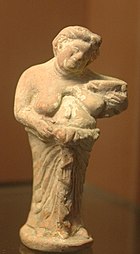Greek terracotta figurines

Terracotta figurines are a wide range of small figurines made throughout the time span of
By the Hellenistic period, as well as a continuing production of religious figures, there was a near-industrial mass-production of sophisticated decorative figures, many of fashionably dressed women, which were often painted. These are the so-called Tanagra figurines, though Tanagra was only one centre of production. Figurines provide an invaluable testimony to the everyday life and religion of the ancient Greeks.
Techniques of manufacture
Modelling

Modelling is the most common and simplest technique for terracotta sculpture. It is also used for the realization of bronzes: the prototypes are made out of raw clay. The small sizes are directly worked with the hand. For the larger models, the coroplast (κοροπλάθος koropláthos, maker of figurines) pressed the clay pellets or wads against a wooden restraint.
Molding

The mold is obtained by application of a bed of clay or plaster on the prototype. Simple molds, used by the Greeks of the continent until the 4th century BC, are simply dried. Bivalvular molds, borrowed by the insular Greeks from the Egyptians, require cutting to obtain an obverse and a reverse, with which "keys" are sometimes associated protuberances allowing the two parts to fit better. When the piece becomes complicated, with important projections (arm, legs, head, clothing), the craftsman can cut out the mold in smaller parts. The piece is then dried.
The second phase consists of applying a layer of raw clay inside the mold, which can be incised beforehand in order to obtain effects of relief. The thinness of the layer varies according to the type of object to be realized. The faces of the mold are joined together, the object is then unmolded, and the craftsman can proceed to the final improvements, typically smoothing the junction. The craftsman also creates a small opening, a vent hole that allows steam to escape during the firing. The vent can also be used for assembly, allowing intervention inside the piece. The limbs are then joined to the body either by pasting them with slip, clay mixed with water, or by mortice and tenon joint.
Firing and completion
The piece is then fired in the
for green.Religious functions

Due to their low cost, figurines were widely used as religious offerings. That was their initial purpose, with the decorative aspect coming only later. Excavations at many ancient
These figurines can present identification issues. These attributes make it possible to recognize a particular god in an unquestionable way, such as the bow for Artemis. Moreover, certain types of statuettes correspond to a precise form of worship related to a specific divinity. Sometimes, however, "visiting gods" complicate matters: these are figurines dedicated to a god who is not of that sanctuary. In addition, the great majority of the figurines simply represent a woman upright, without attribute. These latter figurines were offered in all sanctuaries, independently of the divinity.
The gift of figurines accompanied every moment of life. During pregnancy, future mothers had care to offer a figurine to
The terracotta figurines were often purchased at the entry of the sanctuary. They were the offerings of the common people, who could not afford to dedicate more valuable objects. They were also used to replace offerings in kind, like animals or food. They were placed on the benches of the temples or close to the cult statue. They were also deposited in places of worship outdoors:
Ludic and decorative functions

From the 4th century BCE, the figurines acquired a decorative function. They began to represent theatrical characters, such as
Terracotta was often used for dolls and other children's toys. Examples have been found of articulated figurines or small horses, easy to manipulate for small hands. Sometimes, the nature of a figurine is difficult to determine, such as the curious bell-idols from Boeotia, which appear at the end of the 8th century BCE. They were equipped with a long neck and a disproportionate body, cylindrical and lathe-shaped. The arms were atrophied and the legs mobile. The head was pierced with a hole to hang them. It is uncertain if they were toys or votive offerings.
See also
- Ancient Greek vase painting
References
- Musée du Louvre.
Bibliography
- (in French) S. Besque, Figurines et reliefs grecs en terre cuite, ed. Réunion des Musées Nationaux, Paris, 1994 (ISBN 2-7118-2793-3)
- (in French) V. Jeammet :
- La Vie quotidienne en Grèce : des terres cuites pour la vie et l'au-delà, ed. Réunion des musées nationaux & Musée du Louvre, coll. « Chercheurs d'art », 2001
- Feuillets du Louvre, Louvre et Réunion des Musées nationaux, vol. V, No. 332–334, 2000
- R. Higgins, Greek Terracottas, Methuen, coll. « Methuen's handbooks of archaeology », New York, 1967
- Hoffmann, Sanne (2023). Between deity and dedicator: the life and agency of Greek votive terracotta figurines. Berlin Boston: De Gruyter. ISBN 9783110768879.
- (in French) B. Holtzmann and A. Pasquier, L'Art grec, La Documentation française, coll. « Manuels de l'École du Louvre », 1998
- (in French) R. V. Nicholls, "La Fabrication des terres cuites", Histoire et archéologie, 81 (1984), pp. 24–31
- W. Stevenson, The Pathological grotesque Representations in Greek and Roman Art, Ann Arbor, 1975
